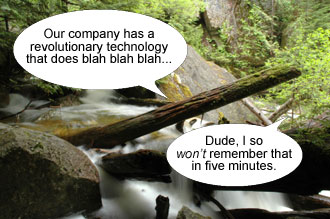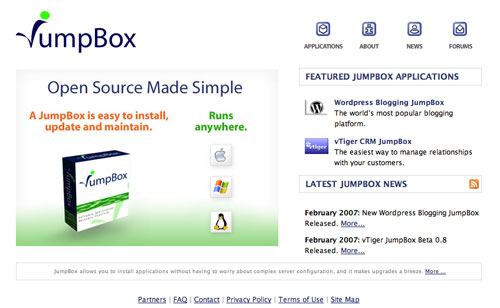Robert Scoble, author of the popular blog Scobleizer, was in town last week to keynote the Revolution in Marketing Conference. Chris Heuer from the Social Media Club also flew out from NYC to present. We captured all the audio sessions and made them available here in streaming format as well as downloadable MP3’s. Thanks to Francine Hardaway for organizing the conference all the sponsors and facilitators that made it possible.
If you’re a startup in Arizona seeking to take advantage of the Angel Tax Credit program, here is what I recommend you’ll need:
Psychic abilities – the AZ Dept of Commerce wants you to project tax returns for your startup into the year 2012. Does anyone else have a clue what their tax returns will look like in five years? It reminds me of the Mitch Hedberg line:
Interviewer – “Where do you see yourself in 5 yrs?”
Interviewee – “Umm, celebrating the 5th year anniversary of you asking me this question!“An impossible history for your company consisting of three years of past financials. That’s right. They want to see three years of history for companies to be eligible. Sooooo, let me get this straight- this program is intended to help secure angel investment for startups and yet you have to be in business three years in order to qualify? Hrmmm…- A PhD in beauracracy with a minor in non-sensical studies – you really just have to read the email exchange below to appreciate the Yossarian-esque “Department of Redundancy Department” ridiculousness.
- Five months of lead time to get them to actually read your application. I filed our app on Oct 5th of 2006 when we were raising money thinking it would be a nice bargaining chip to have in negotiations with potential investors to close anybody that was on the fence. Wow, I’m glad we didn’t need that chip… it took them until March 2nd to even read our application. I can understand if there’s a backlog of applications because the program is so wildly popular, but they’ve certified 25 companies in 5 months. That’s five a month… one each week… what are these people doing the rest of the time?
 I couldn’t find the 13-page application anywhere on their site but fortunately i saved a copy of the one I completed. I emailed the lady last week but given their response time thus far I’m not holding my breath for an answer from her until August.
I couldn’t find the 13-page application anywhere on their site but fortunately i saved a copy of the one I completed. I emailed the lady last week but given their response time thus far I’m not holding my breath for an answer from her until August.
Our friends from Fortymedia were recently kicked out of their garage by the City of Tempe – they have zero foot traffic and are a small web design shop that’s been around and paying taxes for years. Apparently there’s some fine print in the CCR’s about not being able to rent and work from home – another case of a city official with nothing better to do…
If AZ is so interested in engaging in programs that promote growth and development in small business, a good place to start would be to stop f’ing with companies and let them be productive. People are betting their life savings to start a venture, working 15-hr days and gritting it out in an effort to build important things. Entrepreneurs hold the greatest promise of economic growth for AZ – why the heck is City and State so bent on suffocating startups with hoop after senseless hoop? If they’re not going to provide assistance the least they can do is get out of the way. It’s a miracle that small companies succeed in spite of our government.
Anyways, sorry for the rant but this Angel Tax Program is a complete joke. I hate to discourage anyone from trying. It looks great on paper but clearly has some serious fundamental contradictions given its criteria and its stated purpose on the web site.
UPDATE: So I stand corrected on the psychic and history aspects – apparently they’re a state entity asking authorization to federal records for past periods if they exist and pre-auth for the next five years since that’s the time the credit will apply. That’s a little more logical. Five month response time is still messed up though.
***************
Sean Tierney Mar 2 (4 days ago) to Tiffany XXXXXXXX date Mar 2, 2007 9:53 AM subject Re: JumpBox's Application for Angel Investment Program mailed-by gmail.com Tiffany, wow. I completely forgot about this- we applied on Oct 5th... better late than never I suppose ;-) Answers to your questions inline: > NAICS number 541512 - Computer Systems Design Services > relationship between JamStack, Inc. and JumpBox, Inc. Same entity- it was once called JamStack and we then formally renamed the entity to JumpBox, Inc. Let me know if you need the ammended articles for this. > You indicated Sean Tierney does not receive annual compensation. When do you > anticipate he will begin receiving compensation? In the mean time, does the > company provide worker's compensation and are other employee-related state > and federal provisions being followed? I am Sean Tierney - I provided the initial investment to launch the company and I'm currently the largest shareholder. I was not taking salary at the time this app was submitted however I just recently began drawing a very small salary as we landed some critical investment to advance things. It's puny at this point and merely covering my monthly payment on my HELOC. Yes, we file state and federal taxes and follow all the appropriate provisions. I can give you the Q4 tax papers for both if you need them to verify this. > All applicants must submit a completed Arizona Department of Revenue Form > 285SBI. Your form is not quite complete. To comply with the statutes of > this program, we need to obtain an authorization for release of confidential > information for the tax periods two years proceeding the investment year and > for all years the tax credit is available. This includes the three year > carry forward period. Therefore, please submit a revised form 285SBI and > add 2009, 2010, 2011, and 2012 to the tax periods listed on #4. The form > can be found on the web at > http://www.azcommerce.com/doclib/finance/angel%20285sbi.pdf ? Tiffany, please call _me_ (you guys serve the businesses of AZ, right?). This company is 7 months old. I filled out the form to the best of our ability - if you need more information call me with specifics. It's taken you guys 5mos to read our app Pardon me but do you guys have anyone actually using this program? Hopefully you can understand why it seems like a complete joke from my perspective... > Your application contained the Certificate of Incorporation for JamStack, > Inc, which you identified as your business' previous name. Please provide > the amendment to the Certificate that changed the business name to JumpBox, > Inc or provide JumpBox's own Certificate of Incorporation. see attached > If you have any questions, please feel free to contact me. I look forward > to working with you. Thanks! Tiffany, thanks for your time. Please indicate the specific deficiencies on the application I submitted. We can give you whatever tax papers you request for Q3 and Q4 of 2006. We do not have 3 years of anything to give you because we are a startup that was founded in July. I understand that this Angel Tax credit program is geared towards startups like ourself so I'm not sure how you can seriously expect 3yrs of anything from us- unless I'm misunderstanding what you're asking for... please call me and we'll clarify what remains to qualify us.Sean 602.281.4648
and nobody is able to repeat it, does it make a sound?
Okay, maybe a bit corny in the repurposing of that famous existential question, but the key point is this:
Your elevator pitch is only as good as the ability of your listener to repeat it. It’s not about cramming your entire story into a single breath but about providing resonance with the listener. If he/she forms no meaningful association and ascribes no importance to it, it is quickly forgotten. The converse is that it’s grokked in a personal and meaningful way and will be recalled in a later situation when appropriate. And the difference is that the message will then be re-transmitted.
 This point was hammered home in an exercise we did recently in our Fasttrac Growth Venture class. Typically at the beginning of every class each student delivers the most refined version of his/her elevator pitch to the class and gets feedback. The twist in the latest exercise was that you didn’t deliver your own pitch, you had to deliver somebody else’s. Class began as usual but instead of giving our pitch we were told to point at another student. Once every student was pointing at someone unique, each pointee was told to recite the pointer’s pitch.
This point was hammered home in an exercise we did recently in our Fasttrac Growth Venture class. Typically at the beginning of every class each student delivers the most refined version of his/her elevator pitch to the class and gets feedback. The twist in the latest exercise was that you didn’t deliver your own pitch, you had to deliver somebody else’s. Class began as usual but instead of giving our pitch we were told to point at another student. Once every student was pointing at someone unique, each pointee was told to recite the pointer’s pitch.
This exercise wasn’t so much a test of if people were paying attention or not- it was more a test of the transmissibility of the pitches themselves. In other words, an inability to accurately relay someone else’s pitch is more a reflection on the weakness of the pitch vs. the deficiency of the listener. This is a simple yet mind-blowing exercise that demonstrates the importance of how the messaging is received. Unless you’re pitching a potential investor, the role of your pitch is a condensed sound bite for your company that stakes a piece of mental real estate in that person’s mind so that next time he/she meets someone at a cocktail party that needs what you have, you come to mind immediately.
So the takeaway is this:
 Crafting a pitch in the absence of feedback is like spending energy to build the perfect steel-reinforced bridge half-way across a river- it’s pointless unless it connects to the other side. Try out your pitch on some friends. Then approach them three days later and ask them to repeat what they remember. Whatever comes back is what stuck – it is the essence of how your pitch is currently received. Just like the game of telephone where the message gets garbled in re-transmission, your pitch is only as good as that final version which gets relayed second-hand at the cocktail party. Doing recon on that second-generation essence gives you invaluable info about how your pitch needs to be altered.
Crafting a pitch in the absence of feedback is like spending energy to build the perfect steel-reinforced bridge half-way across a river- it’s pointless unless it connects to the other side. Try out your pitch on some friends. Then approach them three days later and ask them to repeat what they remember. Whatever comes back is what stuck – it is the essence of how your pitch is currently received. Just like the game of telephone where the message gets garbled in re-transmission, your pitch is only as good as that final version which gets relayed second-hand at the cocktail party. Doing recon on that second-generation essence gives you invaluable info about how your pitch needs to be altered.
 It’s a small win today but this blog just landed its 100th reader according to the feedburner stats. I’ve been writing for two years now and you better believe I’m hugely grateful each time that counter increments because it means there’s one more person out there that values the content here enough to spend a minute of their day to continue reading. So thanks for being a reader- I promise to keep the dubs spinnin’ ;-)
It’s a small win today but this blog just landed its 100th reader according to the feedburner stats. I’ve been writing for two years now and you better believe I’m hugely grateful each time that counter increments because it means there’s one more person out there that values the content here enough to spend a minute of their day to continue reading. So thanks for being a reader- I promise to keep the dubs spinnin’ ;-)
One of my goals for ’07 is to get more interaction with readers and foster a dialogue here. I’ve added the ability to subscribe to comments on individual posts via email – that should help facilitate that. If you follow this blog take a minute to chime in and say who you are and what you do.
At the very least you’ll get a free link from a PR7 web site and I’ll have a better picture of who’s reading.
If there’s one concept you learn this month that has the single greatest potential to improve the profitability of your site, the power of DIY multivariate analysis using the Web Optimizer is it. Let me explain.
What is Multivariate analysis and why should you care?
Multivariate analysis in the context of web sites is the science of changing elements on a page and studying the effect they have on your visitors’ behavior. If you have a web site, presumably you already have a goal and your site facilitates a behavior from visitors that contributes towards achieving that goal. There is likely a desired outcome you’re seeking on each visit – an action you want that person on the other side of the wire to take such as filling out a contact form or purchasing a product. This desired outcome is known as a conversion.
Improving your conversion ratio even one percent can lead to massive improvements in sales and profitability. This calculator is a simple way to run some what-if scenarios given your current order size, traffic and sales numbers. The easiest way to understand the benefit of improved conversion is to think about it as “miles per gallon” on a vehicle- think how much gas you would save if you doubled the fuel efficiency of your engine? But it’s even better with web traffic. If your current cost per acquisition for a customer is $5 per customer given all your fixed design/development/hosting costs and marginal costs like advertising, converting twice as many visitors with zero additional cost can bring your cpa down to around a dollar. This has a dramatic effect on profitability of your operation – the effect on profitability is non-linear especially if you feed the savings back into targeted promotion.
How GWO works
So now that you understand the value of improving conversion, let’s talk about how GWO specifically does it. Google Web Optimizer is javascript-based multivariate analysis tool that gives you the ability to test different versions of key pages on your site to determine the winning formula that produces the highest conversion. You set up experiments and GWO will dynamically serve different flavors of the same page randomly to different visitors and record the number of resulting conversions. The empirical data is then presented in a graph like the one below. Provided you have enough traffic to produce significant results, the tool reveals the winning combination along with the confidence level of the suggestion (ie. the statistical significance).
You can see that Graphic #4 outperformed the others and crushed the original graphic by almost double.
And the winner is…
So this is all nice in theory but let’s take a look at a concrete example of how this helped us refine our messaging on the JumpBox site. A week ago I set up GWO on the JumpBox homepage and tested five different versions of the main graphic. Here’s the five versions I tested:
Can you guess which one performed the best?
(scroll down for the answer)

(keep going…)
 (wait for it…)
(wait for it…)
 (waiiiit for it….)
(waiiiit for it….)


This version converted at a rate of 21.2% – double that of the original which performed at 11.3%. The breakdown for all is as follows:
 |
 |
 |
 |
 |
| Combo 2 16.1% |
Combo 3 11.6% |
Combo 1 18.7% |
Combo 4 21.2% |
Original 11.3% |
Personally I thought gradients were unfashionable in ’96 but that just proves that conversion is not necessarily about spectacular design. The designers who create spiffy pages and defend their effectiveness from a design standpoint may be completely missing the boat in terms of the effectiveness of the design in converting traffic. Nobody can argue with real numbers from your own visitors – at that point the winning choice is no longer speculation, there is a right answer as confirmed by empirical data.
Anyways, it should be noted that for the purposes of this experiment I counted a conversion as a click through to the about page to read more about the JumpBox technology. Down the road it will make more sense to count a download of our free trial as the conversion but I did it this way for now to get more data immediately on the effectiveness of the homepage graphic for moving people to that next page. I didn’t utilize the multivariate capabilities of GWO either- i used it more as an A/B split test (actually, A/B/C/D/E split). GWO can juggle permutations of headlines, graphics, text, calls to action, and any other displayable element on the page and intelligently report the winning assembly of items. Another aside, we used StumbleUpon advertising as a fire hose of semi-qualified traffic that we could turn on at will to accelerate testing. This worked very well.
What you do if you are interested in using GWO
The video tutorial from Google nails the setup process so I won’t rehash the steps for how to implement it. GWO is in private beta at the moment but it seems they’ve been letting in groups more frequently lately so sign up here and wait for your number to be called. You’ll know you’re in when you see this additional tab appear in your adwords account:

My only complaints about the tool so far are related to usability – it’s not quite there yet for non-technical users. You will need access to paste javascript code into your web pages as well as the technical ability to do so. I would love to see GWO use a single block of js that you install once and allows you to run experiments serially without having to strip out the old js and re-paste in the new. Google’s best move going forward with this will be to author plugins for the popular CMS platforms and ecommerce engines to simplify adoption and save people from ever having to futz with javascript at all. Other than those gripes, this is an amazing tool for people with web sites. No more speculative argument about “this design is way better than that one” – now there is a definitive answer to which designs and promotions work best.
Have fun with it.
 Dear wrinkle-resistant shirt technology – I <3 you. I'm letting go of all my traditional button-down ex's. I've told off my ironing board and thanks to you I can now spend an extra five minutes sleeping in every morning.
I have no idea how you do what you do but I'm thankful.
A Valentine Haiku just for you:
Creases are ugly.
Dear wrinkle-resistant shirt technology – I <3 you. I'm letting go of all my traditional button-down ex's. I've told off my ironing board and thanks to you I can now spend an extra five minutes sleeping in every morning.
I have no idea how you do what you do but I'm thankful.
A Valentine Haiku just for you:
Creases are ugly.
But I despise ironing.
With you… irked no more.







